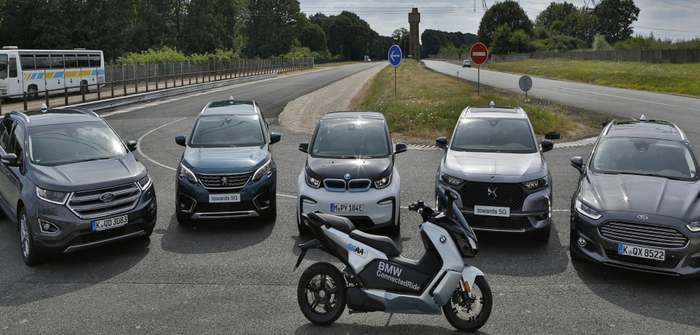A number of companies from the 5G Automotive Association (5GAA) have performed Europe’s first live demonstration of cellular V2X (C-V2X).
The technology uses real-time direct communications over ITS (intelligent transport systems) spectrum and the display demonstrated the technology’s ability to work without cellular network coverage.
The BMW Group, Ford Motor Company and Groupe PSA, in collaboration with Qualcomm Technologies and Savari, set up the display to show how automotive companies can work together to establish communication between vehicles and infrastructure to make traffic safer and support future AVs.
A number of different types of warning procedures were demonstrated: warnings of emergency braking ahead, collisions at intersections, slow and stationary vehicles, traffic lights, vehicles ahead making turning manoeuvres across traffic, and of vulnerable road users such as pedestrians.
The vehicles involved included electric scooters provided by BMW and passenger vehicles from Ford, PSA and BMW Group, all of which were equipped with the C-V2X direct communication technology using the Qualcomm 9150 C-V2X chipset solution. V2X software stack and application software, along with roadside infrastructure, were provided by Savari.
The C-V2X technology supports two complementary transmission modes: direct communication where vehicles communicate directly with each other or with the infrastructure, like in the demonstration; and V2N network communication.
The latter leverages mobile operators for connectivity and delivers cloud-based services, such as weather condition information, parking spot location and automatically notifying emergency services in the event of a crash.
“With its ability to safely and securely connect vehicles, along with its evolution into 5G, C-V2X is integral to Ford’s vision for future transportation in which all cars and infrastructure talk to each other,” said Thomas Lukaszewicz, manager automated driving, Ford of Europe.
“We are very encouraged by preliminary test results in Europe and elsewhere which support our belief that C-V2X direct communications has superior V2X communication capabilities.”
“This demonstration of interoperability between multiple auto makers is not only another milestone achieved towards C-V2X deployment, but also further validates the commercial viability and global compatibility of C-V2X direct communications for connected vehicles,” said Enrico Salvatori, senior vice president and president of Qualcomm EMEA.
By Illya Verpraet


